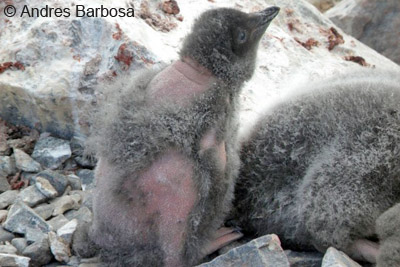Seitenstruktur
-
Spitsbergen-News
- Select Month
- March 2020
- February 2020
- March 2019
- January 2019
- December 2018
- September 2018
- June 2018
- May 2018
- April 2018
- March 2018
- February 2018
- January 2018
- December 2017
- November 2017
- October 2017
- September 2017
- June 2017
- May 2017
- April 2017
- March 2017
- February 2017
- January 2017
- December 2016
- September 2015
- April 2015
- March 2015
- February 2015
- January 2015
- December 2014
- October 2014
- August 2014
- June 2014
- May 2014
- April 2014
- March 2014
- November 2009
- April 2000
- Select Month

| Grytviken |
Home
→ August, 2014
Monthly Archives: August 2014 − News & Stories
Feather-loss disorder observed in antarctic penguins
The feather-loss disorder is an avian disease that leads to the loss of part of the plumage. It has been observed on a number of occasions in penguin colonies in South Africa and South America since 2006. Little is known about the disease. It is not even understood if it is caused by bacteria or viruses.
In January 2014, the feather-loss disorder has, for the first time, been observed in Antarctica. The Adelie penguin colony in Hope Bay, on the northeastern Antarctic Peninsula, is one of the largest of its kind in Antarctica, with about 120,000 breeding pairs. It is routinely censused every week by personnel from the nearby Argentine station Esperanza. In January, one chick, about 15-20 days old, was found with partly missing plumage, exposing parts of the skin. The remaining feathers were easily blown away even by wind gusts. Lice or other influences were not observed. The chick died 2 days later.
Another chick was subsequently found in another part of the colony, about 1 kilometre away. This second affected chick could, however, not be investigated in any detail, as it disappeared and did not come back. Presumably, it died soon.
No other affected penguins were observed. It seems accordingly that the feather-loss disease does not spread easily; it is possible that it affects only penguins with a suppressed immune system or a genetical disposition.
It is unknown how the disease came from South Africa or South America to Antarctica. The risk of further spreading is also completely unknown. It seems, however, likely that staff from base Esperanza who had been in touch with penguin colonies in Argentina may unintentionally have brought the disease with them. Tourism might be another vector, but it is compulsory for tourists to disinfect boots and to clean clothing and other equipment carefully before arrival in Antarctica and any landing there, to prevent spreading diseases or alien plant species.
Adelie chick with feather-loss disorder. Hope Bay, Antarctica, January 2014. Photo: Andres Barbosa.

Source: Antarctic Science
News-Listing live generated at 2025/June/15 at 13:42:19 Uhr (GMT+1)

























